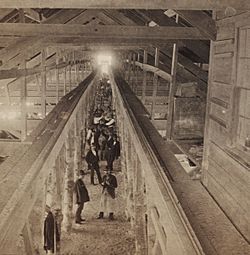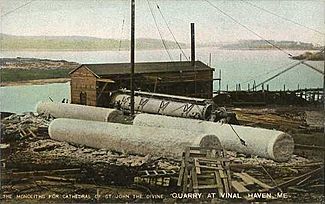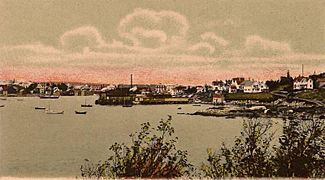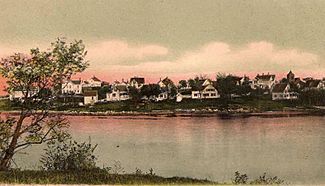Vinalhaven, Maine facts for kids
Quick facts for kids
Vinalhaven, Maine
|
|
|---|---|
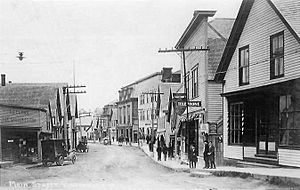
Main Street c. 1915
|
|
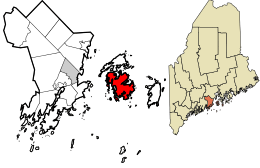
Location in Knox County and the state of Maine.
|
|
| Country | United States |
| State | Maine |
| County | Knox |
| Incorporated | 1789 |
| Area | |
| • Total | 168.69 sq mi (436.91 km2) |
| • Land | 23.46 sq mi (60.76 km2) |
| • Water | 145.23 sq mi (376.14 km2) |
| Elevation | 39 ft (12 m) |
| Population
(2020)
|
|
| • Total | 1,279 |
| • Density | 55/sq mi (21.1/km2) |
| Time zone | UTC−5 (Eastern (EST)) |
| • Summer (DST) | UTC−4 (EDT) |
| ZIP Code |
04863
|
| Area code(s) | 207 |
| FIPS code | 23-79130 |
| GNIS feature ID | 0582782 |
Vinalhaven is a small town located in Knox County, Maine, United States. It's mostly made up of Vinalhaven Island, which is the biggest of the Fox Islands. The town also includes smaller islands, some of which you can reach by bridge.
In 2020, about 1,279 people lived here. Vinalhaven is famous for its busy lobster fishery. Many people also visit in the summer. Since there isn't a bridge to the island, most people get to Vinalhaven by taking a 75-minute ferry ride from Rockland. You can also fly there by air taxi from Knox County Regional Airport.
Contents
Island History and Early Settlers
People have lived on Vinalhaven Island for a very long time. Archeologists have found signs that the Red Paint People lived here about 3,800 to 5,000 years ago. Later, the island became part of Abenaki territory.
Europeans first visited in the 1500s. An English captain named Martin Pring called the islands "Fox Islands" in 1603. The first permanent English settlement began in 1766. Thaddeus Carver arrived from Massachusetts and bought land on the southern shore.
Soon, more families came to live in this remote fishing and farming community. On June 25, 1789, Vinalhaven officially became a town. It was named after John Vinal, who helped get the town recognized. In 1847, the northern part of the island became its own town called North Haven.
Granite Quarries and Famous Buildings
In the early days, fishing, shipbuilding, and logging were important jobs on Vinalhaven. In 1826, people discovered high-quality granite here. For the next 100 years, Vinalhaven became one of Maine's biggest granite quarrying (mining) centers.
Today, you can still see many old, abandoned quarries on the island. Many of these have filled with water and are now popular swimming spots for locals and visitors. The unique pinkish-gray Vinalhaven granite was used in many famous buildings.
You can find Vinalhaven granite in the State Department Building in Washington. It was also used in the Brooklyn Bridge in New York City. Other buildings include customs houses and post offices in cities like New York; St. Louis; and Kansas City.
The granite was also used for the Washington Monument and federal buildings in the capital. It even provided stone for the Cathedral of Saint John the Divine in New York City.
Lobster Fishing Community
Vinalhaven is well-known for its lobster fishing. The island's fishermen have rights to fish in much of Penobscot Bay. They have used these fishing grounds for hundreds of years. Besides lobster, they catch fish like cod, haddock, pollock, and halibut.
Vinalhaven lobstermen were the first in the United States to form a union. They started organizing in 2012-2013. This happened because they were frustrated with low lobster prices.
Filming and Recent Events
The 2006 movie Islander was partly filmed on Vinalhaven. Some local people even acted in the movie.
Geography
The town of Vinalhaven covers about 168.69 square miles (436.91 square kilometers). Most of this area, about 145.23 square miles (376.14 square kilometers), is water. The land area is about 23.46 square miles (60.76 square kilometers).
Population Information
| Historical population | |||
|---|---|---|---|
| Census | Pop. | %± | |
| 1790 | 578 | — | |
| 1800 | 858 | 48.4% | |
| 1810 | 1,052 | 22.6% | |
| 1820 | 1,308 | 24.3% | |
| 1830 | 1,794 | 37.2% | |
| 1840 | 1,950 | 8.7% | |
| 1850 | 1,252 | −35.8% | |
| 1860 | 1,667 | 33.1% | |
| 1870 | 1,851 | 11.0% | |
| 1880 | 2,855 | 54.2% | |
| 1890 | 2,617 | −8.3% | |
| 1900 | 2,358 | −9.9% | |
| 1910 | 2,344 | −0.6% | |
| 1920 | 1,965 | −16.2% | |
| 1930 | 1,843 | −6.2% | |
| 1940 | 1,629 | −11.6% | |
| 1950 | 1,427 | −12.4% | |
| 1960 | 1,273 | −10.8% | |
| 1970 | 1,135 | −10.8% | |
| 1980 | 1,211 | 6.7% | |
| 1990 | 1,072 | −11.5% | |
| 2000 | 1,235 | 15.2% | |
| 2010 | 1,165 | −5.7% | |
| 2020 | 1,279 | 9.8% | |
| U.S. Decennial Census | |||
In 2010, there were 1,165 people living in Vinalhaven. The population density was about 49.7 people per square mile. Most residents (97.6%) were White. About 24.2% of households had children under 18. The average age of people in Vinalhaven was 45.1 years.
Energy on the Island
Vinalhaven is home to one of the first big wind power projects on the U.S. east coast. In 2008, the people of the Fox Islands Electric Cooperative voted to approve this project. They hoped it would make electricity cheaper for island residents. Before this, the island got its power from the mainland through an underwater cable.
Three large wind turbines started working in late 2009. These turbines can produce enough energy for the whole island. This is especially true in the winter when the turbines often make more power than the island needs.
The wind turbines have helped lower power bills. However, some nearby residents have complained about constant noise and vibration from the turbines.
Education
- Vinalhaven School is the public school for students from kindergarten through 12th grade.
- The ARC is a local non-profit center. It offers hands-on learning for different jobs and skills.
Places to Visit
There are many interesting places to see in Vinalhaven:
- Browns Head Light
- Heron Neck Light
- Lane's Island
- Saddleback Ledge Light
- Vinalhaven Historical Society & Museum
Several buildings and places in Vinalhaven are listed on the National Register of Historic Places. These include:
- Browns Head Light
- Heron Neck Light
- Murch Family House
- Pleasant River Grange No. 492
- Saddleback Ledge Light
- Star of Hope Lodge
- Union Church of Vinalhaven
- Vinalhaven Public Library
- Moses Webster House
Notable People
Many interesting people have connections to Vinalhaven:
- Margaret Wise Brown, a famous children's book author
- Caitlin Cahow, a hockey player
- Gerald Edelman, a scientist who won a Nobel Prize in 1972
- Robert Indiana, an artist known for Pop Art
- Leverett Saltonstall, a former governor of Massachusetts
- Ketch Secor, a musician from the band Old Crow Medicine Show
See also
 In Spanish: Vinalhaven (Maine) para niños
In Spanish: Vinalhaven (Maine) para niños


